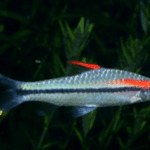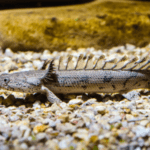With their sunset-colored bodies and peaceful demeanors, honey gouramis (Trichogaster chuna) catch eyes of aquarists desiring unique centerpiece fish. However, providing these specialized labyrinth fish appropriate foods to match unique nutritional requirements proves vital for long-term health.
Table of Contents
Flake and Pellet Diets
Quality protein-rich flakes and small pellets should form their nutritional foundations.
Tropical Flakes
Select a base flake diet containing over 30% minimum crude protein levels from whole fish and supplemented with Spirulina algae. These meet basic honey gourami needs.
Betta or Cichlid Pellets
Additionally offer small pelleted foods designed specifically for carnivorous betta fish or insectivore dwarf cichlids to better satisfy honey gourami appetites and nutritional demands.
Live or Frozen Fare
Supplementing prepared diets with the following gives added variety.
Bloodworms and Brine Shrimp
Both live and flash frozen options like bloodworms, brine shrimp (adult or baby), daphnia and glassworms get readily accepted. Limit these to occasional treats only though, not daily staples.
Mosquito Larvae
When available, introduce small live mosquito larvae (wrigglers) to truly excite their predation reactions mimicking behaviors in the wild. Just ensure larvae get cultured cleanly beforehand.
Vegetable Matter
While honey gouramis primarily consume meaty fare, the following fibrous foods aid their digestion.
Spinach and Zucchini
Blanch tough greens like spinach and drop in sinking wafers for supplemental grazing. Uncooked peeled zucchini slices get devoured as well. Secure vegetables by skewers or veggie clips to prevent loose pieces dirtying water.
Spirulina Enhanced Foods
Choose flake and pelleted foods specifically containing Spirulina ingredients. This nutritious blue-green algae provides torn fiber honey gouramis often lack in captivity benefiting overall health.
Conclusion
Honey gouramis thrive best on a combination carnivore diet offered via quality protein-rich prepared staple foods supplemented with an assortment of thawed frozen meaty items and fibrous vegetable matter to satisfy nutritional requirements as specialized labyrinth fish. This maintains both brilliant coloration and peak conditioning long term.
FAQs About Honey Gourami Diets
1. How often should you feed honey gouramis?
Offer honey gouramis several small pinches of a combo diet once to twice per day. Monitor overall growth rates and body conditions, increasing or decreasing amounts accordingly to maintain ideal still-streamlined physiques.
2. Do honey gouramis eat plants?
While deriving little direct nutritional value from live plants, honey gouramis may sample tender leaves or munch on delicate stems in planted setups without causing too much damage overall. Ensure plenty of preferred foods get offered to limit grazing needs.
3. What are good tank mates for honey gouramis?
Select similarly sized peaceful community tankmates for best compatibility with honey gouramis. Some great options include small rasboras, tetras, danios, Corydoras catfish and bristlenose plecos that largely ignore them.
4. Can honey gouramis thrive in cold water?
No, honey gouramis require warm stabilized temperatures between 72-82°F to remain healthy. Acclimate them slowly when introducing to avoid temperature shock. Use adjustable heaters to maintain warmer conditions their metabolism depends upon.
5. What causes honey gouramis to lose color?
Faded, drab coloration results from poor water quality, unsuitable pH levels, aggression from inappropriate tankmates, inadequate diets lacking proper nutrients or symptoms of underlying illness. Address the root cause to restore brilliant hues.






I¦ll immediately clutch your rss as I can not find your e-mail subscription hyperlink or newsletter service. Do you have any? Please allow me recognize in order that I may subscribe. Thanks.